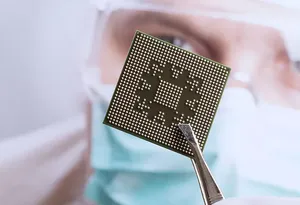Types of 8-bit single chip microcontrollers
In the expansive realm of electronics, the eight-bit single-chip microcontroller has carved a significant niche, especially in the arena of embedded system projects. Often fondly referred to as '8-bit MCU', these tiny powerhouses integrate a CPU, memory, and input/output peripherals onto a single chip, making them indispensable for a variety of applications.
These controllers are categorised based on their architecture, peripheral integration, application areas, and memory types. So, let’s delve deeper into the type of 8-bit single-chip microcontrollers available.
By Architecture
- Harvard Architecture: Unlike von Neumann systems, these MCUs have separate memory for instructions and data, giving them an edge in speed. Models include the PIC series fromMicrochip.
- von Neumann Architecture: This design permits shared memory for instructions and data. Though slower, it offers programming simplicity. The 8051 family from Intel exemplifies this model.
By Integrated Peripherals
- Analog Features: Such microcontrollers come equipped with ADCs and DACs, capable of converting signals from analog to digital and vice versa. These features are vital for applications requiring real-time environmental interaction, such as sensor data capture and signal processing. The ATD (Analog to Digital Converter) and D/A (Digital to Analog converter) amplifiers and sensors work seamlessly for any questiion on controlling the environment with microcontrollers. Example models are the Atmel AVR and PICs.
- Communication Features: With integrated communication interfaces, certain 8-bit MCUs stand out. They feature built-in support for protocols like UART, SPI, and I2C. For instance, Microchip's PIC series and Atmel's AVR MCUs can effortlessly connect and exchange data with other devices or microcontrollers, thus powering the Internet of Things (IoT) innovations and assisting with embedded system projects.
- Timers and Counters: Time management and counting tasks are essential in numerous applications. Many 8-bit microcontrollers incorporate programmable timers and counters for this purpose. This is especially useful for measuring time intervals, generating accurate waveforms, or even monitoring the numerical events.
By Application
- Industrial Applications: In industrial settings, these microcontrollers control machinery and automation systems. Their ability to perform basic tasks and interface with sensors and actuators makes them ideal for monitoring and control systems.
- Consumer Electronics: Everyday gadgets such as remote controls, washing machines, and microwaves rely on 8-bit microcontrollers. Their cost-effectiveness and sufficient processing power handle the basic functions of these devices.
- Automotive Systems: In automobiles, microcontrollers manage and monitor systems like engine control, air conditioning, and power windows.
By Memory Type
- Flash Memory Microcontrollers: Thanks to their reprogrammable Flash memory, these controllers make software updates simple and are frequently employed in consumer electronics.
- EEPROM-based Microcontrollers: Utilizing EEPROM memory, these microcontrollers can store data even when power is off. They are the best option for applications that need data logging and retrieval.
Specifications and Functionalities of 8-bit single-chip microcontrollers
Key Specifications
- CPU Speed: Most of these microcontrollers operate at a clock speed range of 1 to 40 MHz, giving them enough power to carry out basic operating functions without high power consumption.
- Memory: Most have program memory ranging from 512 bytes to 64 kilobytes. Data memory is commonly available from 32 bytes to 4 kilobytes. Certain types of Microcontrollers ensure the availability of special memory addresses for specific purposes, like storing data for frequently used variables (registers) or interrupt vectors.
- Input/Output Pins: An 8-bit microcontroller typically has between 8 and 40 I/O pins that can be programmed. This variance depends on the complexity and reach of the project at hand. The greater the number of I/O pins, the larger the project can control various components or interfaces.
- Power Supply: Power supply requirements usually span from 2.0V to 5.5V. This enables usage in battery-operated systems and electronic devices.
Functions
- Data Processing: The primary function of these microcontrollers is data processing. They execute a series of instructions on an 8-bit data, making them capable of handling various signal types in different applications.
- Control Operations: They manage various operations by controlling motors, LED displays, and other appliances based on incoming data received by the sensors.
- Interfacing: The involvement of these microcontrollers with other electronic components is important. They send and receive analog and digital signals to and from sensors and actuators. This way, they control and monitor systems efficiently.
- Program Execution: These microcontrollers can execute stored program instructions in a systematic sequencing manner. This feature allows for application consistency and much easier operational procedures.
How to Choose 8-bit single-chip microcontrollers
A microcontroller's performance varies based on the operational task, thus making it important to select the appropriate one. Listed below are important factors that help with selecting the right one.
Project Requirements
Determining the level of control an embedded system project requires is key. Complex projects may call for controllers with enhanced peripheral integration and more I/O pins. At the same time, simple ones will be just fine with basic functionality.
Cost Considerations
Budget constraints play a key role during selection. Generally, these microcontrollers are affordable and in high supply. Basically, the choice will depend on brand reputation and features.
Development Environment
Some manufacturers provide enhanced programming environments that enable faster and easier development. Generally, the toolchain available may significantly impact the development time and project cost. For instance, Microchip's MPLAB and Atmel Studio from the AVR family offer robust debugging and simulation capabilities.
Longevity and Availability
It is important to consider the availability of microcontrollers in the market. It is also worth checking the manufacturer’s commitment to support over a long period.
Community and Technical Support
Moreover, a strong community support such as existence of tutorials, forums and open-source projects can help a lot in the developing process and at the same time implementing solutions for problems encountered when working with a particular microcontroller.
Scenarios of 8-bit single-chip microcontrollers
- Home Automation: In home automation systems, the 8-bit single-chip microcontroller works as the controlling component. It responds to temperature, humidity, and motion sensors by switching on the air conditioning, lights, or alarms. This shows how embedded system projects can improve living conditions with a 38 pin microcontroller by adding convenience and efficiency.
- Medical Devices: Such microcontrollers are gradually taking up the role of data processing in medical equipment. For instance, they can control dosages in infusion pumps or display patient data on medical monitors. Their reliability and low power consumption make them ideal for those critical portable medical devices.
- Industrial Automation: In industries, these microcontrollers help automate machinery operations. They are the sensors' data processors and control the machines based on the given parameters. This leads to an improvement in efficiency, precision, and safety of operations and reduces the needs for manual interventions.
- Wearable Technology: Wearable gadgets such as fitness bands and smartwatches use these microcontrollers to manage health-related data. Things like heart rate, step counts, and sleep patterns are monitored and processed. This makes it easier for users to get insights into their well-being.
- Remote Control Systems: The 8-bit single-chip microcontroller is the most used component for embedded system projects in remote control systems. For instance, in a television remote control, the microcontroller processes user commands, sending out signals. These help provide a reliable and cost-effective solution for operating various devices from a given distance.
- Educational Tools: These microcontrollers are employed in education kits to teach students and beginners microcontroller concepts. They handle basic programming and project creation.
Q&A
Q1: What is the main role of an 8-bit single-chip microcontroller?
A1: The main role of an 8-bit single-chip microcontroller is to control and manage embedded systems. However, in a 38 pin microcontroller, data processing, control operations, interfacing, and program execution are the major functions.
Q2: What makes 8-bit microcontrollers suitable for beginners in embedded systems?
A2: 8-bit microcontrollers are ideal for beginners because the programming and circuit complexity are simple. Moreover, they also come with a variety of educational tools and resources.
Q3: What are the key factors to consider when choosing an 8-bit microcontroller for a project?
A3: There are three key factors one should consider when selecting a microcontroller for a project. They include project requirements, cost, and the availability of development tools.
Q4: Where are 8-bit microcontrollers applied in medical devices?
A4: These microcontrollers are applied in a variety of medical devices. They include infusion pumps, patient monitors, and portable diagnostic equipment. They help control dosages and display patient data.
Q5: How do these microcontrollers contribute to home automation systems?
A5: The microcontrollers automate controlling systems in home automation. They help improve living conditions by providing efficiency and convenience through the automation of routine tasks.
































